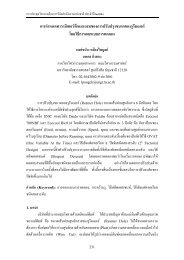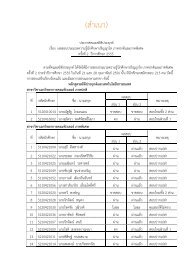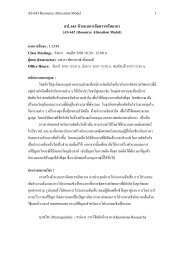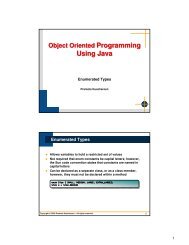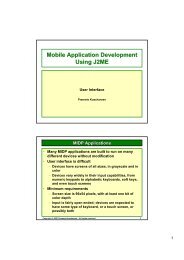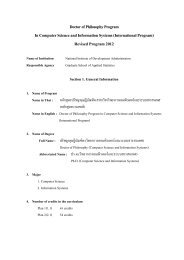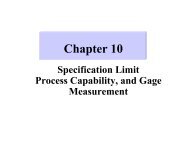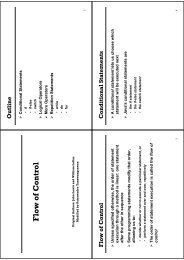ดาวน์โหลด All Proceeding - AS Nida
ดาวน์โหลด All Proceeding - AS Nida
ดาวน์โหลด All Proceeding - AS Nida
Create successful ePaper yourself
Turn your PDF publications into a flip-book with our unique Google optimized e-Paper software.
Fig. 3 Response Surface and its Contour Plot.<br />
On the theory and practice of RSM, it is assumed that the<br />
mean response (η) is related to values of the process variables (ξ1, ξ2, …, ξk) by an fitted unknown mathematical function f [3]. The<br />
functional relationship between the mean response and k process<br />
variables can be written as η = f (ξ), if ξ denotes a column vector with<br />
elements ξ1, ξ2, …, ξk. Estimation of such surfaces, and hence<br />
identification of near optimal setting for process variables is an<br />
important practical issue with interesting theoretical aspects.<br />
The procedure begins with any types of experimental<br />
designs around the current operating condition. A sequence of first<br />
order model and line searches are conventionally justified on the basis<br />
that such a plane would be fitted well as a local approximation to the<br />
true process response. The estimated coefficients of multiple regression<br />
models are usually determined by the method of least squares. A<br />
sequence of run is carried out by moving in the direction of steepest<br />
descent with the predetermined step length. In contrast to this other<br />
algorithmic processes search the system approximation via the<br />
systematic searches or the measurement of the response in the design<br />
points. When curvature is detected, another factorial experimental<br />
design is conducted. This is used either to estimate the position of the<br />
optimum or the systematic searches to specify a new direction of<br />
steepest descent or the new design point with the better yields.<br />
In this study, the mixed integer linear constrained response<br />
surface optimization model (MI-LCRSOM) is deployed to set up a<br />
relationship of the linear constrained responses and both types of<br />
influential process variables. Originally, linear programs are problems<br />
that can be expressed in canonical form:<br />
46<br />
Minimize C T X<br />
Subject to AX ≥ B<br />
And X ≥ 0<br />
where X represents the vector of process variables (to be<br />
determined), C and B are vectors of (known) coefficients and A is a<br />
(known) matrix of coefficients of problem constraints. The expression<br />
to be maximized or minimized is called the objective function (C T X in<br />
this case). The constraints Ax ≥ B specify a convex polytype over<br />
which the objective function is to be optimized. In this problem, some<br />
of the unknown variables are required to be integers. The problem is<br />
then called a mixed integer linear programming (MILP) problem.<br />
Sequential procedures of MI-LCRSOM are repeated. A factorial<br />
experiment design is use to investigate the optimal responses of process<br />
of interest. When the model is formulated, analysis of variance<br />
(ANOVA) is applied to find statistically significant process variables<br />
and determine the most effective levels. Regression analysis is used to<br />
fit a relationship equation of the response and its factor. A restriction of<br />
process variables is also considered as the constraints of the process. A<br />
mathematical programming is use to find the optimal levels in each<br />
process variable via a generalized reduced gradient algorithm that can<br />
bring the suit levels.<br />
3.2 Mixed Integer Linear Constrained Response Surface<br />
Optimization Model (MI-LCRSOM)<br />
In order to optimize the response of meandering that might<br />
be influenced by several process variables various sequential procedures<br />
via statistic tools are then used. One among those is the multiple<br />
regression analysis. It is used to determine the relationship between the<br />
influential process variable of x’s and the dependent process variable or<br />
response of y that is modeled as a linear or nonlinear model. Multiple<br />
regression fits a linear relationship between the value of x’s and the<br />
corresponding conditional mean of y and has been use to describe the<br />
linear phenomena.<br />
To minimize the variance of the unbiased estimators of the<br />
coefficients, multiple regression analysis played and important role in<br />
the development of regression analysis, with a greater emphasis on<br />
issues of design and inference. An aim of regression analysis is to




